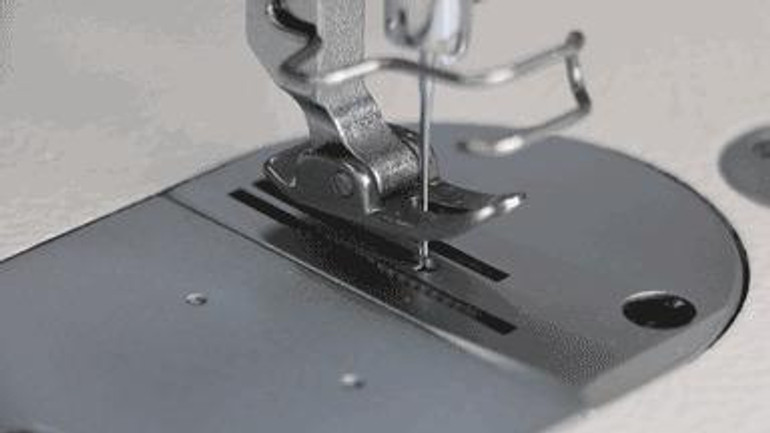Every sewing machine features a form of feeding that allow them to move materials to create a stitch. Because of this, it’s beneficial to understand the differences between these feeding mechanisms so you can choose the one best suited for your next project. In this handy blog, we’ll explain the key distinctions, uses and drawbacks of a few popular feeding mechanisms: a drop feed, walking foot, compound walking foot and a puller feed system.
What Is a Drop Feed System?
The most common type of feeding mechanism in a home sewing machine (and some industrial machines) is the drop feed, also known as the regular feed system. This method utilizes feed dogs underneath the foot to advance the fabric through the machine. By controlling how the material is fed through the machine, you can control the direction of the stitch and the length of the stitch. In a drop feed system, the movement occurs when the needle is out of the fabric. As the needle plunges into the fabric, it creates a stitch and when the needle is up, the bottom feed dogs grab the fabric and move it along through the machine.

A closer look at the drop feed system.
Uses: Thinner materials or those with only a few layers, such as quilting and fashion projects.
Drawbacks: Because the fabric is only grabbed by the bottom feed dogs, projects with multiple layers may experience shifting because not every layer is fed consistently. Drop feed mechanisms cannot easily transition between fabric thicknesses. It’s also difficult to maintain a consistent stitch length in thick materials because you have to push the fabric through the machine.
What Is a Walking Foot?
In this system, the well-defined teeth of both the walking foot and the feed dog grab and release the fabric from the top and bottom in unison while the needle is out of the fabric. This method eliminates uneven top and bottom feeding and reduces puckering because all layers of the fabric assembly are fed consistently through the machine in one fluid motion. Think of it like rowing a boat, where both oars move forward at once and then pull back together.
Because a walking foot mechanism will grab and feed all the layers of your assembly evenly, you won’t have to worry about your project shifting or some layers not being properly sewn, even if they’re comprised of different materials. The unique movement of a walking foot raises higher than other feeding mechanisms, which allows it to climb up multiple layers of fabric with ease.

A closer look at the walking foot.
Uses: The walking foot is a great choice for assemblies with varying layers, such as projects that abruptly jump thickness, like from fabric to webbing. Many DIYers choose walking foot sewing machines to tackle heavy canvas, upholstery fabrics, quilting materials, curtain material, Sew Foam, vinyl, soft leather or slippery fabrics like those used in sail-making.
Drawbacks: When sewing very lightweight fabrics such as silk, a walking foot system can cause surface damage to the delicate material. This can often be rectified by purchasing additional specialty feet and feed dogs, which adds cost to the machine.
What Is a Compound Walking Foot?
Often called a compound feed, needle feed or triple feed, this is a two-part system where the needle moves in tandem with the inner presser foot to pull the fabric through the machine. With a compound walking foot, the inner presser foot and needle walk by moving up, forward, down and back to feed and stitch the assembly consistently.
The outer presser foot moves up and down, keeping uniform pressure on the assembly, preventing it from shifting when the needle is removed from the fabric. When the inner presser foot lowers onto the fabric and the fabric is penetrated by the needle, the outer presser foot momentarily raises from the assembly. This allows the assembly to be pulled by the needle and inner foot, promising uniform stitches and zero shifting, even with thick fabrics.

A closer look at a compound walking foot.
Uses: The compound walking foot can handle both thick and thin applications but works exceptionally well for projects of a consistent thickness and long seam runs. It easily handles materials in the upholstery, canvas, automotive, marine and leather sewing trades. A compound walking foot is especially helpful for leather assemblies of uniform thickness such as wallets, belts, holsters and bags.
Drawbacks: This system can only do straight stitches. The compound walking foot does not perform quite as well transitioning over bumps and thickness changes as a standard walking foot.
What Is a Puller Feed?
Primarily used in sail lofts, this system is a modification of the drop feed system. The only difference is that, with a puller feed system, you’ll notice supporting rollers that both pull and apply downward pressure to the material to help drag it through the machine. When you sew with a puller feed system, the fabric is fed through the machine like a drop feed but the additional roller behind the presser foot pulls at the same rate as the feed dog.

A puller feed mechanism on an industrial machine.
Uses: This type of feeding mechanism is suitable for long, straight runs or large radius curves.
Drawbacks: These types of machines may be pricey. In addition, some only operate in one direction which can make reversing a little more challenging, and they don’t work well for intricate sewing or tight turns. They’re best for production seaming operations where they can help to keep stitch rows very straight and consistent. Lastly, the puller can be disengaged for intricate sewing but the mechanism is still bulky and sits behind the presser foot, which is where you generally don’t want large obstructions when sewing shaped items (for example: a round bottom bag end).
Last Remarks
Hopefully, we’ve helped shed some light on the differences between sewing machine feeding mechanisms.


 Canadian Dollar
Canadian Dollar

